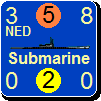brian brian
Posts: 3191
Joined: 11/16/2005
Status: offline

|
well this thread is gone too and we can't have the strategic thinking of the bad guys lost in space now can we? Here is the counterpart to what I just bumped the German thread with:
So one day early this summer there was a long line at my local
K•Mart and I decided to skip that and waste a few more minutes
perusing their bookshelves. I was quite surprised to find a copy of
"Rising Sun Victorious: An Alternate History of the Pacific War," a
volume I had been considering special ordering since reading a
similar volume on Germany last year. (Somehow I suspect I'll never
see a similar edition for Italy). The original publisher of both was
Greenhill Books in the UK and Stackpole in the US, who both
publish a specialty line of alternative history titles, but the volume I
found was a cheap regular (not a 'trade') paperback from Presidio
Press / Ballantine, so these titles must be enjoying some
commercial success; this mass-market edition includes a bonus
second sub-title "It could have happened ... and nearly did." This
lucky find probably took a year or more off my time to ever get
around to finishing this project.
Once again, I will synopsize each of the ten chapters, and include a
brief summary of how each might apply to a game of World in
Flames, but this time I will go sequentially from the first chapter. For
this book once again the overall editor is Peter G. Tsouras, and the
author list features experienced military history writers and/or
professional Military Intelligence officers.
#1: Hokushin - The Second Russo-Japanese War - obviously from
the title, more of the Soviet-obsessed Army planners prevail in
Japan's major strategic choice of 'Go North' or 'Go South'. One of
the things I really like about these books is the bibliographies for
each chapter. This one nearly right off the bat references a familiar
figure for WiFCon attendees, David Glantz, but more importantly
reveals the works of one Alvin D. Coox. This author has written a
probably incredibly detailed book on the battle of Nomonhan, given
that the page citations feature numbers greater than 1,000, as well
as another book on the lesser known border incidents at
Changkufeng/Khasan in 1938. If you ever wanted more info on
these arcane battles of WWII, the material is out there. In this
alternative, Japan strikes at the Soviet Union in August of 1941.
Ditching their original “Hachi-Go” plan of driving towards Irkutsk
based on the fore-mentioned battles with the Russians, they scale
back and focus on seizing the Soviet Maritime Province from south
of Khabarovsk to Vladivostok, wisely placing General Yamashita in
overall command. The Soviets play into this by moving divisions
from Siberia to the German front a bit earlier than historically,
frittering away said units at Kiev rather than holding them for the
decisive struggle in front of Moscow. The Japanese attack is a
resounding success, taking Khabarovsk and Vlad. by December.
The IJN destroys most of the Russian submarine forces with
surprise strikes on their docks. Meanwhile, Stalin is deposed as the
USSR unravels from both ends. Roosevelt steps in as mediator in
the spring of 42; with no political capital at home for war in the
Pacific after the Japanese staffed their Siberian adventure with
large and very public withdrawals from Indo-China and parts of
China itself, he trades away the Netherlands East Indies for a
continued American presence in the Phillipines and prepares to
face a very large wolf on the other side of the Atlantic.
WiF perspective: I think a Japanese attack on the Soviet Far East is a no-brainer, and only needs to be timed carefully with German strategy. Even better is lulling the Soviets into doing the DoW, and of course it can sometimes be a simple matter to get even more goodies in Persia. The extra resources and Vladivostok's red factory certainly help prepare the Empire's defenses against the might of the U.S. of A. Would they be a decisive game-winner? Probably not, but it might add a few turns to Japan's existence at the end. But most of you reading this know the ins and outs of Russo-Japanese war in WiF. And if Barbarossa is on-going at the time, you might as well make a try for Chita or at least the 4th Siberian resource south-east of there, but Japan’s logistics can limit this desire. I would also like to note that I think the WiF presumption that every major port has bomb-proof SUB pens has always seemed a little generous to me, though I also feel SUBs are a bit under-powered in WiF, particularly against enemy capital ships. This chapter also only briefly touches on the political ramifications in America had Japan pursued this strategic line. I've always thought the USE chit roll for a Japanese DoW on the USSR should perhaps be a -7 rather than a +7 for a country so anti-Communist, and of course WiF lacks any mechanism to simulate the US entry ramifications of theoretical Japanese concessions in China. And like many alternate historical lines, this one would work best in a more open-ended game that would allow more independent play by the various Major Powers, a la a true Days of Decision game, Avalon Hill's classic "Diplomacy."
#2: Failure of War Plan Orange - Somehow in the election campaign of 1940, American war planning for the Phillipines becomes a political issue, leading Roosevelt (and tangentially MacArthur) to guarantee a strong defense of the islands and the precious "American sons" stationed there. This leads to the dusting off of the ancient War Plan Orange which presumes that upon outbreak of war with Japan, the American battleship fleet will 'fight their way through' in WiF parlance, from Hawaii > Wake > Guam > Manila, defeat the IJN in the process, and thus allow reinforcements to reach the Phillipines. The Japanese pick up on this shift in American planning and cancel their strike on Pearl Harbor, instead merely invading the Phillipines on December 7th. MacArthur is caught off guard, losing most of his air assets on the ground, but to save some face he falsely claims his B-17s sink six Japanese carriers in the South China Sea. Halsey is rather skeptical, but for the BB admirals it's damn the torpedoes. However since the torpedoes in question are the famous 'Long Lance', the joke is on them as Japanese attrition tactics destroy nearly the entire pre-war Pacific Fleet with only the Arizona and the Augusta temporarily reaching Manila in exchange for the loss of the Hosho, Ryujo, and the Mutsu. (The Americans commit their CVs to disparate regions of the Pacific singly and lose the Lexington and Saratoga). Shaken by such a massive defeat, Dug-Out Doug is forced to sign the truce with Japan. The NEI is again sacrificed, this time for Japanese guarantees not to invade New Zealand or Australia.
WiF Perspective: Of course, WiF has no way to simulate the civilian pressures on the decisions of the leaders of the Western democracies. But many a WiF game ends early when a player throws in the towel, and losing 7 battleships, 2 carriers and a whole bunch of cruisers all in one turn could perhaps lead a player to push the re-set button. Perhaps. The author of this one, Wade Dudley, does note "It is difficult to imagine any simple set of circumstances that would have allowed Japan to win any form of victory in WWII.", and that is important to keep in mind for all ten chapters. But in WiF you only have to survive past turn 36; the challenge of that for the Japanese is why we play the game I guess.
#3: 3rd Wave at Pearl Harbor - Several quirks of history break for the Japanese and Pearl Harbor is an even more devastating blow. The Enterprise is not delayed by bad weather for two days, putting it much closer to the action, and is found by Japanese recon; half of the first wave is diverted to sink her. Meanwhile at Pearl the USS Nevada gets up steam as per history, but rather than grounding herself off to the side, she is blown up at the narrowest point of the main channel, effectively ruining Pearl as a fleet base for six months. With no chance of a USN sortie and one CV already accounted for, Nagumo launches the great what-if of this battle, the 3rd wave of bombers. These complete the destruction of the base, including the famous oil-tank farm, the machine shops, and the submarines as well, though this costs the Japanese the Zuikaku and Shokaku, lost to the strike force from the Enterprise that launched before her destruction and refuels between waves in Hawaii. Pearl is completely ruined until April of 1942, just when Yamamoto returns with the Combined Fleet, this time escorting ground forces...
WiF Perspective: Pearl Harbor, Schmearl Harbor, who cares? I don't think this could win the war for the Japanese in WiF or history. The Essex class would still turn the tide eventually in history; in WiF losing Pearl just teaches the US player that Calcutta can be an even better base, since the game makes it a US primary supply source with no concern for the massive logistics investment that would actually be required to make this happen (I would think the shipping required from the USA would have delayed Overlord quite substantially), and lets you sail through an enemy held strait of Malacca as many times as you want with nary a scratch. WiF could really use a new naval unit - light coastal forces to represent torpedo boats and other tactics that make restricted coastal waters dangerous for capital ships.
#4: Intell operations in the Coral Sea - The Allied press replicates the famous slip-up of the Chicago Tribune, revealing the Allied success at breaking Japanese codes, after the Battle of the Coral Sea rather than after Midway. The Japanese change all of their codes before Midway, and add 4 additional light carriers with 120 more planes to the strike force. This is done via human couriers while radio planning remains the same; two light cruisers take on the call signs of the carriers leading the feint towards the Aleutians, for example. The actual resulting battle of Midway is not described in this chapter, rather the historical chess-like operations of the small carrier forces in the south-east Pacific in the spring of 1942 and the thinking that leads the Japanese to discover their signals problem. Another chapter in this book informs me that wargame designer John Prados has written an entire book on this very topic of Japanese naval codes. I hope to find a copy.
WiF Perspective: Not a lot is applicable here, though the implications are more developed in the next chapter. The game could really use a way to simulate code-breaking and the resulting advantages for high-level military commanders, but that would be hard to design without decreasing playability, WiF's #1 most important trait. I'm hoping this will be possible some day in editions of the computer version after the first.
#5: Nagumo's Luck - USN Commander McCluskey returns to Midway rather than turning northwest and never finds the Japanese CVs; they are thus unmolested to launch their massive strike against the US flat-tops and sink all three of them. The Battle of Midway is a decisive Japanese victory, including a conquest of the island itself. For a while things look positively giddy for the Axis world-wide as the US panics and cuts off Lend-Lease to the British and the Russians, reeling under the German attack in the summer of 42. The Japanese drool at the prospects of bombing the US west coast at will and even using their battleships to shell American airplane factories, conveniently located up and down the Pacific coast. They also decide to destroy the Panama Canal, St. Nazaire style, by blowing up an explosives laden destroyer in the main lock. But this author brings the fun to a halt as the Japanese inexplicably can't get these operations under way until early October. By then the US has moved the vulnerable factories inland and set up a ground-based version of a modern AWACS plane in the islands off of Los Angeles, as well as deploying their second most secret weapon of WWII - the anti-aircaft proximity fused shell. When the Combined Fleet arrives the successes of all the land-based air the US can muster leads Yamamoto to break off combat after just thirty minutes, well before the surface units are in range to bombard. US submarines take out the Japanese Panama expedition with just three torpedoes, turning the special destroyer into a mini-mushroom cloud and sinking the escorting CVL with two more. History returns to it's nearly normal course.
WiF Perspective: Losing three carriers is not a devastating blow to the US in 1942, nor is losing Midway as a base. Such a victory for the Japanese would probably benefit them the most on the back-end as the US campaign in the Pacific would be a bit delayed getting in motion and a turn or two of survival might be thus gained in 1945. The author has some interesting ideas that aren't possible in WiF, such as a Strategic Shore Bombardment mission that would be great fun. By 1941 Japan would only have a maximum of two carrier planes with 1 strategic factor each, though if playing without the cvp units the Combined Fleet could put a small dent in US production for a turn or two at the most via strikes on the west coast.
#6: Samurai Down Under - After the Battle of the Coral Sea Japan decides to green-light an invasion of Australia. However they also continue the Midway operation as planned, with the historical results. The landings in Australia stay within land-based air range from Japanese-held Port Moresby and never threaten even Brisbane and probably just make MacArthur's subsequent advance into New Guinea a bit easier. Without further developing alternative outcomes such as the carrier battle that one would think would probably have occurred as the US went to relieve an Australia threatened by a bigger Japanese expedition had there been no Midway, this scenario really goes nowhere except to illustrate that showboat MacArthur and Australian General Blamey probably wouldn't send each other Christmas cards after the war.
WiF Perspective: None really; at a minimum in WiF one would want to occupy Brisbane and deny the USN a great base, at least temporarily. Who has ever even seen units placed in Cairns and Townsville by either side in WiF? Even if Japan goes 'All-In' and conquers Australia, it rarely has the shipping to exploit the captured resources for long, as in WiF Calcutta generally replaces one of Australia's historical roles as the base for a USN SUB campaign. Nor does Japan always have the army and the lift necessary to make this an easy operation. It is nice to sever the Pacific in two, but that comes at the price of increasing the size of the defensive perimeter and doubling the size of Japan's critical convoy routes. It is unfortunate this book doesn't try out a Japanese attack on South Africa, an exciting op in WiF particularly when the Euro-Axis has made the Med into a private lake, but the professional Military Historians writing these probably rightly judge that Japan would never have been able to pull off the needed logistics for that.
#7: The Japanese Raj - Again Japan gives in to temptation to expand their war aims, this time setting their sights on India. One kick and Britain's Indian Empire collapses like the rotten house of cards that it already was. The British grant independence to the Muslim areas, leading to the creation of Pakistan during the war rather than after, and manage to stop the Japanese in front of Karachi, though the US is really the power propping up the place. Ceylon becomes the Malta of the Indian Ocean and never falls, though with no more Burma Road Chiang Kai-Shek is a goner as well. However, given the Japanese exploitive occupation policies, they find India impossible to rule and eventually must give it up as the Americans threaten from the East. But with no organized enemy in China, the Japanese Army is able to keep the Allies from getting any closer than the Mekong River. Unexplained details in Europe keep the Russians out of the Pacific War, and dealing from a position of greater strength, the Japanese 'win' the war by trading the Phillipines back to the war-weary Americans and the Empire survives, albeit with two new problems named Ho and Mao. Strategy & Tactic's David C. Isby wrote this chapter and it is an excellent analysis of internal Indian politics and the real effects WWII had on the subsequent history of the sub-continent. In this alternative, the Japanese occupation changes the post-war dynamics quite a bit and India and Pakistan live happily ever after.
WiF Perspective - Calcutta is the Leningrad of Asia, without any winter weather of course, and a campaign against it can run smack into the game mechanic of placing reinforcements even in totally surrounded hexes. (I always hate that with a passion). Then if you manage to take the hex, it is still a long way to Dehli. However, a Japanese attack on India can net some economic gains for the Japanese, with an easier convoy route home that is actually made safer once Calcutta is taken. I like an Indian campaign for Japan but I do wish undertaking it would have some effect on the relatively absurd situation in WiF China. Would it win the game? It can help get you there I think, but as usual that it can become only a matter of how many turns it gains you in 1945. Perhaps if your European Allies are similarly successful, it could put Japan over the top.
#8: Morale Check at Guadalcanal - The US never relieves Admiral Ghormley from command in October of 1942 and he decides to withdraw from Guadalcanal rather than continue to expose fleet assets to Japanese attacks while trying to maintain supply to the Marines ashore. Further ramifications for the Pacific War are not explored.
WiF Perspective - again none. I've seen games of WiF that no one ever placed a unit on Guadalcanal. Given WiF's playability trade-off of allowing any Pacific island to be an airbase, the place just isn't that important in WiF.
#9: Kurita keeps going - The Japanese activate their Sho-1 plan in response to US landings at Leyte Gulf as per history. Halsey takes the bait and inexplicably leaves the Surigao Strait uncovered. Kurita sinks the force of 'Jeep' carriers he encounters first and then sails on into Leyte Gulf and massacres American lift assets; on the ground the Japanese Army almost eradicates the now un-supplied beach-head. American casualties are the heaviest of WWII. Peace advocates in the Japanese government offer to give back everything taken after Dec. 7, 1941 in exchange for the survival of the Emperor and their original gains in China. Roosevelt, hammered in the press for the disaster in the Phillipines and mindful of the approaching elections, accepts the offer.
WiF Perspective - I could see this happening in WiF. A 1/10 split against a US player that got sloppy arranging his forces in the sea-boxes could really hurt. Heck, this could maybe even happen two rounds in a row, taking out a big pile of the CVL's in one round and then a couple loaded AMPHs in another. Without enough replacements on the build spiral full of O-Chits for the end-game, the American time-table to take objective hexes before the end of turn 36 could be effectively wrecked. You always have to remember when playing WiF that the pieces are made out of cardboard, and if the Axis have too many left at the end, you did it wrong. The historical Japanese certainly had no problems with that philosophy, they just didn't roll high enough.
#10: The Kyushu Turkey Shoot - Four atomic bombs don't rattle the Japanese, particularly after the military launches yet another coup against the leaders who want to surrender after the first two. The Russians have Machuria and probably more; Japan has nothing left...except 12,000 hidden planes that don't really need much fuel to crash in to the now quite nearby American fleet. The Divine Wind Typhoon of October 1945 (a historical storm) takes out enough American shipping that decoy operations are no longer a possibility. When the Americans appear off Kyushu at last, the Japanese strike. Without long flights over the ocean vulnerable to American CAP and the inability of American radar to pick up Kamikazes approaching from the Japanese mountain ranges, the suicide planes sink lots of loaded transports. Losing two out of four Hospital ships and their blood supplies mean American wounded become American dead...and then comes the losses to radiation sickness no one had foreseen after the Americans resort to the first attempts to use nuclear weapons somewhat tactically. With monsoon season on the way, once again the Americans cry Uncle and let the Emperor continue his rule. A very well-written piece carefully extrapolated from the Okinawa experiences as reported in detail by Samuel Eliot Morrison.
WiF Perspective - If you are invading Japan in November of 1945, you have of course already lost and are just playing it out to see what happens. Don't you wish you had vetoed that nasty Kamikaze optional way back before the game started? Note that the American occupation authorities eventually dismantled the mentioned 12,000 planes and discovered enough fuel reserves to fly them.
|
 Printable Version
Printable Version















 GASP
GASP 

 And I don't want this page to be very far, hehe
And I don't want this page to be very far, hehe
 New Messages
New Messages No New Messages
No New Messages Hot Topic w/ New Messages
Hot Topic w/ New Messages Hot Topic w/o New Messages
Hot Topic w/o New Messages Locked w/ New Messages
Locked w/ New Messages Locked w/o New Messages
Locked w/o New Messages Post New Thread
Post New Thread